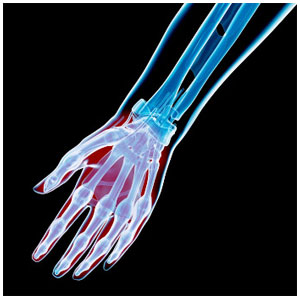As one of the most commonly used and injured parts of the body, hands and fingers can frequently become infected.
Untreated Hand and Finger Infections
Hand infections, if left untreated or treated improperly, can cause disabilities such as stiffness, contracture, weakness, and loss of tissues (skin, nerve and bone). These may persist even after the infection resolves. Therefore, prompt treatment of hand or finger infections are important.

Common Infections of the Hand and Finger
Infections of the hand and fingers include:
Paronychia
Paronychia is an infection of the nail fold or cuticle area present around the fingernail. It may be an acute or chronic infection.
Acute paronychia is a bacterial infection and causes pain, redness, and swelling around the nail. It is caused by superficial trauma that may occur during nail-biting or finger sucking. It can be treated with antibiotics and often needs to be drained.
Chronic paronychia is a result of fungal infection. It causes symptoms such as mild pain, redness, or swelling. It occurs most commonly in people whose hands are frequently wet or are immunocompromised. The treatment for chronic paronychia consists of avoiding constant exposure to moisture and application of topical steroid and antifungal ointments.
Felon
Felon is a serious infection of the fatty tissues of the fingertips and results in throbbing pain. It is caused due to direct entry of bacteria during a penetrating injury, or by the spread of infection from untreated paronychia.
If there is an abscess, surgical drainage is performed. Following, antibiotics will be prescribed.
Herpetic whitlow
Herpetic whitlow is a herpes simplex virus infection of the fingers. It is more common in healthcare workers whose hands are exposed to patient’s saliva that may carry the virus. Herpetic whitlow presents as small, swollen, and painful blisters.
Conservative treatment for herpetic whitlow involves the application of a dry gauze dressing to the affected finger(s) to avoid the spread of infection.
Septic arthritis/Osteomyelitis
Septic arthritis is a severe infection of the joint caused by a wound or draining cyst. The bacterial infection may cause destruction of the joint by eroding away the joint cartilage.
Surgical drainage should be performed as soon as possible. The condition may get complicated if the infection spreads to the bone, causing osteomyelitis.
Deep space infections
Deep spaces are the spaces in between different structures of the hand. These spaces tend to get infected through penetrating wounds or spread of infection from blood. Deep space infections may occur in the thumb, the palm, forearm or in the area between the bases of fingers.
Treatment for deep space infections includes immediate surgical drainage and antibiotic therapy.
Tendon sheath infection
Tendon sheath infection is the infection of the flexor tendon, which occurs from a small laceration or penetrating wound on the finger. It causes stiffness of the finger, accompanied by redness, swelling, and severe pain. Treatment includes immediate surgical drainage and antibiotics.
Infections from bite wounds
Infections from animal or human bites are associated with bacteria such as Streptococcus and Staphylococcus, Eikenella corrodens (human bite injuries), and Pasteurella multocida (dog and cat bite injuries). These wounds are given initial treatment and left open to allow the infection to drain out. These also frequently necessitate surgical drainage and antibiotics.
